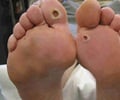
They narrowed the catch down to 26 studies that compared like with like.
Most of the people in these studies were aged over 65 -- an age category in which Type-2 diabetes, also called adult onset diabetes, predominates.
Disability was defined as either crimped mobility or an impaired ability to perform daily activities such as bathing, eating, using the phone, shopping and using transport.
Lead epidemiologist Anna Peeters said the association between diabetes and disability was long known but until now poorly identified.
The causes remain mysterious, she said.
Advertisement
"The complications associated with diabetes, such as heart disease, stroke, and kidney disease, can all result in disability."
Advertisement
The paper appears in the journal The Lancet Diabetes and Endocrinology.
According to the UN's World Health Organisation (WHO), 347 million people around the world have diabetes, a disease in which the body fails to break down glucose in the blood through the hormone insulin.
Ninety percent of these have the Type 2 form of the disease, which typically shows up in adulthood or late childhood, driven by obesity and a sedentary lifestyle.
Source-AFP













